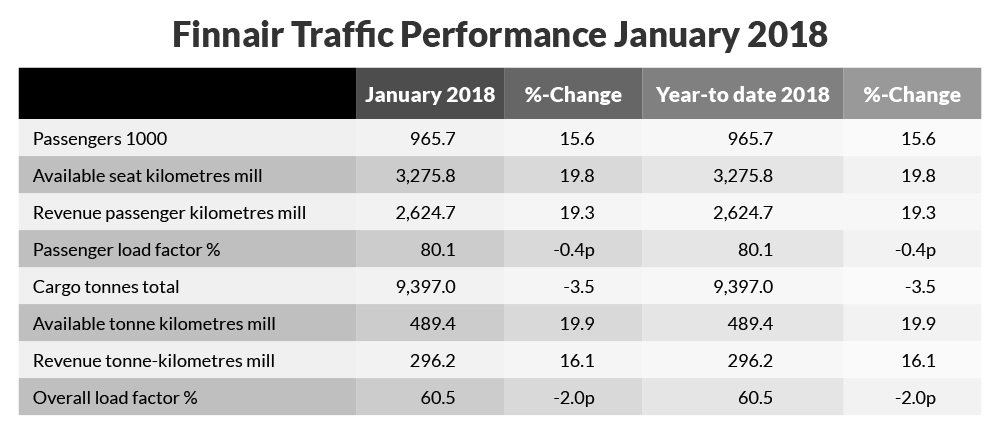Finnair record breaking run continues with a powerful start to 2018
Contributors are not employed, compensated or governed by TDM, opinions and statements are from the contributor directly

Following the record breaking achievements of 2017, Finnair has powered into 2018, displaying the fastest growth in Finnair’s history – the number of passengers grew by 15.6 per cent in January — is still in effect.
I have been so impressed with Finnair over the last few years, since Pekka Vauramo’s (main picture) appointment as CEO), and their commitment innovate and try out new concepts and technologies, a willingness to buck trends — such as retaining free food and drink, when other airlines have introduced fees — make passengers feel they are genuinely cared for. And, not just subject to the whims of accountants and cost reduction.
In January, Finnair carried 965,700 passengers, or 15.6 percent more than in the corresponding period of 2017. The number of passengers grew the most in Asian traffic, 23.2 percent, but growth was also strong on North American routes (+18.0 percent), European flights (+14.0 percent) and domestic traffic (+13.1 percent). More than half of the passengers flew on European flights, more than one fifth on Domestic flights, one fifth on Asian flights and the rest on North American flights.
 In January, Finnair carried 965,700 passengers, or 15.6 percent more than in the corresponding period of 2017. The number of passengers grew the most in Asian traffic, 23.2 percent, but growth was also strong on North American routes (+18.0 percent), European flights (+14.0 percent) and domestic traffic (+13.1 percent). More than half of the passengers flew on European flights, more than one fifth on Domestic flights, one fifth on Asian flights and the rest on North American flights.
In January, Finnair carried 965,700 passengers, or 15.6 percent more than in the corresponding period of 2017. The number of passengers grew the most in Asian traffic, 23.2 percent, but growth was also strong on North American routes (+18.0 percent), European flights (+14.0 percent) and domestic traffic (+13.1 percent). More than half of the passengers flew on European flights, more than one fifth on Domestic flights, one fifth on Asian flights and the rest on North American flights.

Finnair’s overall capacity measured in Available Seat Kilometres (ASK) increased in January by 19.8 percent year-on-year. In long-haul traffic, the capacity was increased mainly by the A350 aircraft introduced after the reference period. Additional capacity was allocated to additional frequencies to Bangkok, Hong Kong, Singapore and Chongqing, as well as to new seasonal routes to Goa, Puerto Plata, Puerto Vallarta and Havana, which replaced Varadero that was operated in the reference period. The ASK growth in Asian traffic was 26.7 percent and in North American traffic 21.0 percent.

The 8.6 percent ASK growth in European traffic derived from the increase in the narrow-body fleet size year-on-year and the additional seating capacity added to some if its existing narrow-body aircraft. Capacity growth was directed at serving the new year-round destination Reykjavik, added frequencies especially to Stockholm, Copenhagen and Berlin and direct flights to Lapland from Paris, London and Zurich. The significant ASK growth in domestic traffic, +30.2 percent, reflects primarily added capacity to destinations in Northern Finland and shows Finnair’s contribution to boosting international tourism in Lapland. In January, 52 percent of Finnair’s ASKs were in Asian traffic, 33 percent on European routes and the rest in North American and domestic traffic.

Finnair’s traffic measured in Revenue Passenger Kilometres (RPKs) grew almost at the same pace with capacity growth, +19.3 percent. The fastest RPK growth was in Asian traffic, +23.8 percent. European traffic grew by 11.2 percent, North American traffic by 23.4 percent and domestic traffic by 16.0 percent. Despite the strong capacity for growth, the aircraft flew full especially on long-haul routes – the Passenger Load Factor (PLF) was 86.8 percent in Asian traffic and 79.6 percent in North American traffic. In European traffic, PLF was 73.6 percent and in domestic traffic 60.1 percent. PLF in total traffic was at the same level as in the comparison period, 80.1 percent (-0.4 percent-points year-on-year).
With such a barnstorming performance in 2017 and early 2018, it will be interesting to see how Finnair will perform in the upcoming months, and whether they can maintain this powerful curve upwards. My money says they will, and expect them to break more records in the coming months.


Comments are closed.